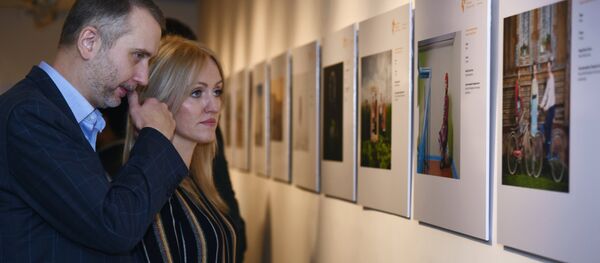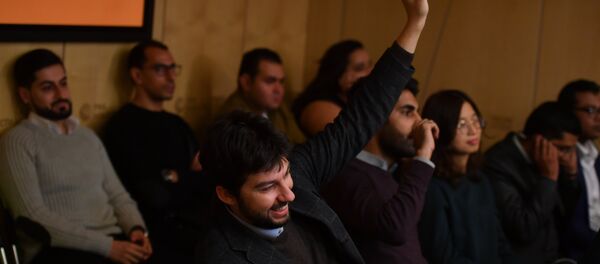New Delhi (Sputnik): Alexey Volin, Russia's deputy minister of Digital Development, Communications and Mass Media, along with a Russian media delegation, visited India recently to build up collaboration between Indian and Russian media. In an interview with Sputnik, the minister explained the importance of media interaction between Russia and India.
Unlike during the Soviet times, there is a lack of direct contact between the younger generations of both countries and his visit aims to build ways to re-establish the bond between the youngsters of the two allies.
READ MORE: Sputnik Becomes Partner of National Radio Network of Uruguay RNU
Sputnik: What is the purpose of your visit?
Alexey Volin: My main objective to come to India is to provide new impetus for our ties and enhance the cooperation in media spheres. At the present moment, we believe that our ties in the context of Russian-India media exchange are not commensurate with the level of the cooperation which should be between our two great countries who call themselves strategic partners.
Let me give you an example. Both India and China together with Russia are members of BRICS. But our cooperation with China in the media sphere accounts for more than one hundred or sometimes two hundred events per year. On the other hand, our engagements in India in the media sphere accounts for not more than 10 to 12 events every year. We certainly understand that these numbers are not good enough. We do see the interest for such cooperation not only from people's side but also from the business' side.
Alexey Volin: We understand that most of the Russian and Indian media houses are business companies. They enrich themselves through ties and communication. That is why we discussed the idea of annual Russian- Indian Forum of Media Representatives which should be held in India and Russia on a turn by turn basis. Two years ago, the first forum was held in Delhi. We can't say that it was a revolution, but there was a good degree of success. We can see that there was a development of ties in the sphere of cinema and in the sphere of the relationship among the TV companies. We are absolutely sure that regular interaction among the main players in the media business will be of mutual benefits to both Russian and Indian markets.
READ MORE: Rossiya Segodnya Information Agency Becomes Trendsetter in Media — Official
Sputnik: What will be the structural form of Russian-India media cooperation?
Alexey Volin: We believe that there could be several segments to take this forward. The first is TV and radio development for the modern-era. The second could be news agencies and newspapers. The third could be new media because we see that more and more people are moving towards New Media from traditional media. The forms of communication in the New Media sphere are different from the traditional forms of communication. We should learn from each other — how to operate, how to work, what the young generation wants to see etc.
More than half of the population in Russia and India is using messengers and social networks. There is no sense in the traditional press releases. There is no sense in articles written in a bureaucratic language, so-called official reports, official releases, etc, because they don't work and nobody reads it. This is because at the present moment traditional media no longer has the monopoly as the only source of information. Now, the alternative way to reach the brain and hearts of people is to use new communication modalities.
Alexey Volin: The main idea in new media communication is that it should be short and interesting information, which could be and should be shared by the users of the social network or by the users of messengers. The sharing is the key aspect. If the content is dull there is no sharing. So we need to use new language styles and we need to teach people to use these new language styles.
Sputnik: Can you give some examples of new media in Russia?
Alexey Volin: In Russia, we have very good schools that work on New Media. There is the school of Russia Today (RT) and also of Sputnik for example. On YouTube, RT has more than 6 billion views. This means that RT's content is interesting. It means that the content is being shared. It also means that proper language is being used for speaking with the people. We are ready to discuss with our Indian partners and Indian colleagues on how to use the experience, and on how to train each other. We have an idea and that is to teach Indian journalists when they come to Moscow where they can do special courses in RT and in Sputnik.
READ MORE: Sputnik Signs Partnership Agreement With India’s Leading News Agency
Sputnik: Can you talk about new technological platforms?
Alexey Volin: New technological platforms is another section for the Russian-Indian Forum of Media Representatives. We understand that in the digital sphere for spreading information internationally especially through mobile platforms, we would need new equipment and new gadgets. It is not enough only to produce content. You need to spread it and you need to find the right technical way to do it.
If you remember I was speaking about the target audience. We used to say that our target audience is the person at the present moment. Although our final target is a person, there is a target device that takes information to him. Say for example a person has three different devices at his disposal — a tablet, a laptop and a smartphone. These are three targets and each of them needs its own form of content creation and has its own platform.
Alexey Volin: This would be another section in the Russian-Indian Forum of Media Representatives. Young journalists need to be tapped. Old journalists know everything and they remember the Russian-Indian relationship, the Soviet-Indian ties, the Soviet-Indian development, etc., but the younger generation knows nothing along these lines. Unfortunately, the level of their knowledge, their general knowledge, in particular, is very narrow and low. The only way here is person-to-person contact because they don't believe in the books. They don't believe in words they believe in communication — in personal human communication. So they need to see each other, they need to see the countries in context; they need to see how our daily life is organised. The Russian young journalists should visit India, and the Indian journalists should go to Russia to see with their own eyes and experience the moods and attitudes for themselves.






